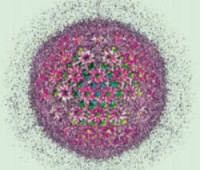Instead of using the traditional epitope mapping approach to identify major targets of the T cell response to a complex pathogen, a group from the University of Massachusetts used mass spectrometry to identify viral proteins associated with immunodominant antigens. These peptides will provide researchers a means to follow and modulate CD4 T cell responses to HHV-6B. The most antigenic protein turned out to be major capsid protein U57.
The novel method involved eluting fractions of extracellular virus preparations or virus-infected cells to analyze the cytokine responses of T cells to human herpesvirus 6B (HHV-6B). First, the group led by J. Mauricio Calvo-Calle tested for IFN-gamma production by CD4 T cells in HHV-6 seropositive donors. From this, ten HHV-6B viral proteins were identified as immunodominant antigens, including U11, a major antigenic protein, and U57. From these ten proteins, a total of 107 peptides were recognized by at least one donor. Furthermore, the majority of donors demonstrated responses to 14/107 peptides. These peptides were from U11, U14 (phosphoprotein pp85), U54 (virion transactivator), U31 (large tegument protein), U48 (glycoprotein H), and U57 (major capsid protein). After identifying these 14 peptides, the researchers tested the specificities of T cells to epitopes from HCMV and HHV-6B. There was no reactivity found between the 14 peptides and the HCMV homologs.
Read the full paper.

